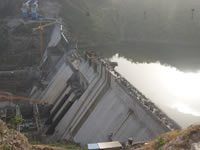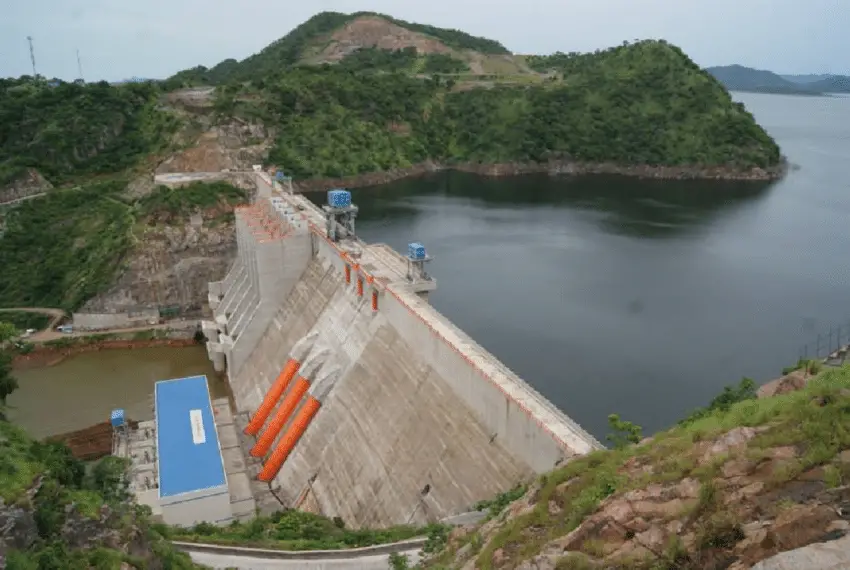A 400-megawatt hydroelectric power project in Ghana is called the Bui Dam. The southernmost point of Bui National Park, in the Bui Gorge, is constructed on the Black Volta river. Sino Hydro, a Chinese construction firm, and the Ghanaian government are working together on the project.
In December 2009, work on the main dam got underway. The dam’s first generator was put into service on May 3 of that year, and it was officially opened in December of that same year. The anticipated total project expenditures are US$622 million. Own funds from the Ghanaian government ($60 million) and two loans from the China Exim Bank, a commercial loan for US 292 million and a concessional loan for US 270 million—are funding the project.
Also Read: Reconstruction of Appiatse community in Prestea Huni Valley, Ghana, well underway
Ghana’s Bui Hydroelectric Power
Reported in March 2013
 Ghana’s Bui Hydroelectric Power To Add 400Mw To Grid
Ghana’s Bui Hydroelectric Power To Add 400Mw To Grid
Introduction
The power sector of Ghana will be boosted by an additional 133 megawatts of power to the generation sector by the end of 2012 when the first phase of the Bui Hydroelectric Power Project is completed.
More importantly, the project will add 400 megawatts of power upon full completion in 2013.
The project will be the third major dam in the country after the Akosombo Dam and the Kpong Dam and is a partnership between the government of Ghana and Sino Hydro, a Chinese construction company and is managed by the Bui Power Authority, on behalf of the government of Ghana.
Background
Field investigations for the dam began in October 2007. In January 2008 preparatory construction began and in May 2008 the first people were resettled. In December 2008 the river was diverted and a year later construction on the main part of the dam began. The filling of the reservoir began in 2011. Sinohydro Corporation is serving as the main contractor while Coyne etBellier is the consulting engineer.
Technical aspects of the construction works
The Bui Dam will be a gravity roller-compacted concrete type and have a height of 108 m (354 ft) above the foundation and 90 m (295 ft) above the riverbed. The crest of the dam will be 492 m (1,614 ft) meters long and sit at an elevation of 185 m (607 ft) above sea level (ASL).
The main dam’s structural volume will be 1,000,000 m3 (35,314,667 cu ft). Southwest of the dam there will be two saddles (or auxiliary) dams to maintain pool levels and prevent spillage into other areas of the basin.
The first and closest to the main dam is Saddle Dam 1. It is 500 m (1,640 ft) southwest of the main dam and will be a rock-fill embankment dam. The dam will rise 37 m (121 ft) above ground level and have a crest length of 300 m (984 ft). Being constructed 1 km (1 mi) southwest of the main dam is Saddle Dam 2.
This dam will be a zoned earth-fill type and have a height of 7 m (23 ft) ASL and a crest length of 580 m (1,903 ft). Both saddle dams will have a crest elevation of 187 m (614 ft) ASL.
The Dam – Flooded area
The reservoir that the main and saddle dams create will have a maximum capacity of 12,570 million m3 of which 7,720 million m3 is active (or “useful”) for power generation and irrigation.
The reservoir’s maximum operating level will be 185 m above sea level (ASL) and the minimum 167 m (548 ft) ASL. At the maximum level, the reservoir will have a surface area of 440 km2 while the minimum will be 288 km2. The reservoir’s volume at a minimum level is 6,600 million m3. The average length of the reservoir will be 40 km with an average depth of 29 m and a maximum of 88 m.
Just downstream of the dam on the left bank will be the dam’s power station. Just above it and at the top of the dam, the intake will feed water through three penstocks which in turn will supply water to three separate 133 MW Francis turbine generators. The power station will have an installed capacity of 400 MW and an estimated average annual generation of 980 GWh. The power station’s switchyard will be located 300 m (984 ft) downstream and will convert the electricity to 161 kV before it reaches main the transmission lines.
The dam’s spillway will be near the right bank and consist of five radial gates, each 15 m (49 ft) wide. The spillway will sit at an elevation of 169 m (554 ft) and have a maximum discharge of 10,450 m3/s (369,038 cu ft/s) which correlates to a 1-in-10,000-year flood. The dam’s outlet works will consist of a single outlet on the right bank converted from one of the diversion tunnels.
Benefits of the Project
The Bui hydropower plant will increase the installed electricity generation capacity in Ghana by 22%, up from 1920 MW in 2008 to 2360 MW. Together with three thermal power plants that are being developed at the same time, it will contribute to alleviating power shortages that are common in Ghana.
Furthermore, like all hydropower plants, the project avoids greenhouse gas emissions that would have occurred if thermal power plants had been built instead. An additional expected benefit is the irrigation of high-yield crops on 30,000 hectares of fertile land in an “Economic Free Zone”. The current status of the irrigation project is unclear.
Cost and Financing
The total project costs are estimated to be US$622 million. It is being financed by the government of Ghana’s own resources (US$60m) and two credits by the China Exim Bank: a concessional loan of US$270 million at 2% interest and a commercial loan of US$292 million.
Both loans have a grace period of five years and an amortization period of 20 years. The proceeds of 30,000 tons per year of Ghanaian cocoa exports to China, which are placed in an escrow account at the Exim Bank, serve as collateral for the loan.
Once the dam becomes operational, 85% of the proceeds of electricity sales from the hydropower plant will go to the escrow account. If not all the proceeds are needed to service the loan, the remainder reverts back to the government of Ghana.
Overall impact Positive and negative
Environmental Impact
The Bui National Park will be significantly affected by the Bui Dam. 21% of the park will be submerged. This will affect the only two populations of black hippopotamus in Ghana, whose population is estimated at between 250 and 350 in the park. It is unclear if hippos can be relocated and if there is any suitable habitat near the area to be inundated. Even if there were such a “safe haven”, it is not clear if the country’s game and wildlife department has the means to rescue the animals.
The Environmental and Social Impact Assessment states that hippos will be vulnerable to hunting during the filling period of the reservoir. It also claims that they would ultimately “benefit from the increased area of littoral habitat provided by the reservoir”.
The dam could also have other serious environmental impacts, such as changing the flow regime of the river which could harm downstream habitats. A survey by the University of Aberdeen has revealed that the Black Volta River abounds with 46 species of fish from 17 families. None of these species is endangered.
Nevertheless, these fish communities could be severely impacted by changes in water temperature, turbidity, and the blocking of their migration. Waterborne diseases could also occur. Schistosomiasis in particular could become established in the reservoir, with severe health risks for local people.
Social Impact
The Bui Bui Hydroelectric Power project requires the forced relocation of 1,216 people, of which 217 have been resettled as of June 2010. In order not to slow down the construction of the dam, the Bui Power Authority has opted for a quick resettlement process.
It neglected the recommendations of a study, the “Resettlement Planning Framework”, that it had contracted itself. In theory, all affected people are expected to be moved to a new locality called Bui City.
However, as of 2010, the city does not exist and there is not even a schedule for its construction. Instead, the first 217 relocated people have been moved to a temporary settlement called Gyama Resettlement Township, which has a dilapidated infrastructure.
Fishers were resettled on dry land and lost their livelihoods. Although the study had recommended establishing an independent body to monitor the resettlement, no such body has been set up.
Conclusion
Looking at the way Ghana’s economy is growing, there is a need to increase the rate of generation capacity by 10% annually, and so projections are that by 2015 Ghana will increase the current generation capacity to 5,000 megawatts. Therefore the construction of the project is one step to achieving the target.

